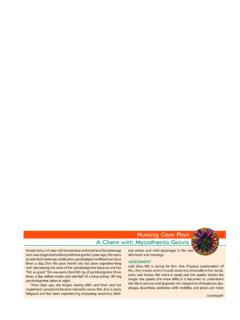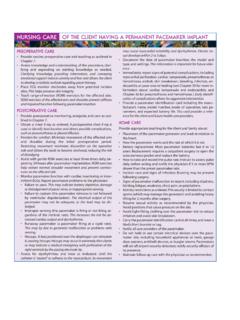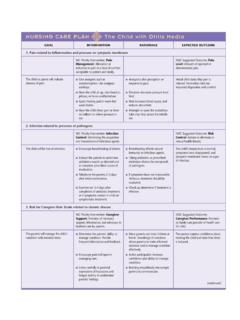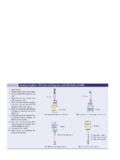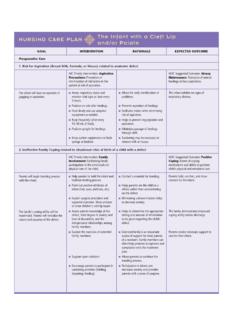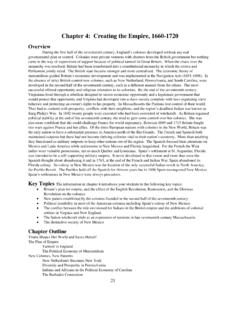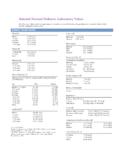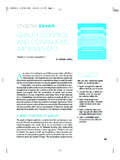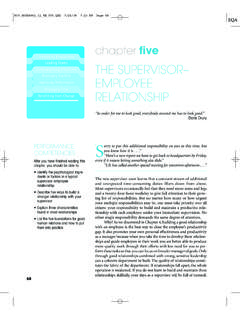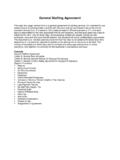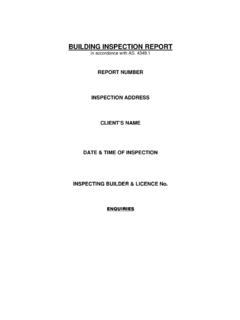Transcription of Nursing Care Plan Note: Data from Nursing …
1 CHAPTER 39 / Nursing Care of clients with Musculoskeletal Disorders1229 CHART 39 1 NANDA, NIC, AND NOC LINKAGESThe Client with OsteoporosisNURSING DIAGNOSESNURSING INTERVENTIONSNURSING OUTCOMES Chronic Pain Medication Administration Comfort Level Pain Management Pain:Disruptive Effects Risk for Trauma Environmental Management: Safety Risk Control Fall Prevention Safety Behavior: Fall Prevention Health Education Self-Care: Activities of Daily Living Teaching: Disease Process Knowledge Deficit: Calcium Intake Teaching: Disease Process Knowledge: Disease Process Teaching: Prescribed Diet Knowledge: Diet Teaching: Prescribed Medications Knowledge: Prescribed MedicationsNote: Data from Nursing Outcomes Classification (NOC) by M. Johnson & M. Maas (Eds.), 1997, St. Louis: Mosby; Nursing Diagnoses: Definitions & Classification 2001 2002byNorth American Nursing Diagnosis Association, 2001, Philadelphia: NANDA; Nursing Interventions Classification (NIC) by McCloskey & G.
2 M. Bulechek (Eds.), 2000, St. Louis:Mosby. Reprinted by Bauer is a 53-year-old schoolteacher. She has been marriedfor 36 years and has two children. Mrs. Bauer says she is 65 inchestall. She has smoked one pack of cigarettes a day for 30 years anddrinks one to two glasses of wine with dinner each evening. Shedoes not routinely exercise. Mrs. Bauer has had symptoms ofmenopause for 8 years, including hot flashes in the early years andmood swings of late. She has never been on hormone replace-ment Bauer is currently seeking medical advice for continuouslow back pain. The pain is not relieved with an over-the-counteranalgesic, and she frequently wakes up during the night becauseof the nurse practitioner notes that Mrs. Bauer s vital signs are allwithin normal limits. She has full range of motion of all extremitiesand is able to stand and bend over, but she reports discomfortwhen returning to the upright position. Mrs. Bauer has a slightlypronounced hump on her upper back and is 1 inch shorter thanher stated height on admission.
3 Her muscle strength is symmetricand Acute painof the lower spine, related to vertebral compression Deficient knowledge,related to osteoporosis and treatment toprevent further damage Imbalanced nutrition: Less than body requirements,related to in-adequate intake of calcium Risk for injury,related to effects of change in bone structuresecondary to osteoporosisEXPECTED OUTCOMES Verbalize a decrease in back pain. Be able to describe ways to treat her osteoporosis and preventfurther complications. Verbalize an understanding of the current research and treat-ment regarding osteoporosis . Verbalize how stopping smoking can helpprevent further progression of osteoporosis . Seek consultation for supplements and medications to preventfurther bone loss. Design a program of physical activity to prevent complicationsof osteoporosis . Verbalize safety precautions to prevent fractures due to AND IMPLEMENTATION Teach back strengthening exercises. Refer to an osteoporosis support group, if available.
4 Provide realistic, yet optimistic, feedback about loss of heightand bone integrity and the potential outcomes of treatment. Assess current knowledge base, and correct misconceptionsregarding treatment of osteoporosis . Provide current educational literature regarding treatment ofosteoporosis. Instruct in dietary and calcium supplements that help preventeffects of osteoporosis . Discuss physical exercises that help prevent complications dueto osteoporosis . Review safety and fall precautions, and provide literature re-garding how to create a safe home her return visit 6 months later, Mrs. Bauer reports that she feelsmuch better. She is no longer irritable and does not experiencemood swings, because she has been taking her prescribed hor-mone replacements for 6 months. She is eating products rich incalcium and taking a daily supplement of calcium with vitamin Bauer has reduced her wine intake to one glass in the eveningand now drinks decaffeinated coffee and tea.
5 She also states thatsince she stopped smoking, she has been walking 30 to 45 min-utes every Care PlanA client with osteoporosis (continued)1230 UNIT XI / Responses to Altered Musculoskeletal FunctionMUSCULOSKELETAL EFFECTS Pain (in the long bones of lower extremities or joints) Deformity (enlargement of skull, bowing of lower extremi-ties, and deformity of elbows and knees) Chalkstick-type fractures of lower extremities Pathologic fractures (especially of the tibia) Compression fractures Collapse of the vertebrae, resulting in kyphosis and loss ofheight Muscle weaknessNEUROLOGIC EFFECTS Hearing loss Spinal cord injuries Dementia Pain from spinal stenosis Bladder and/or bowel dysfunctionCARDIOVASCULAR EFFECTS High cardiac output Congestive heart failure Increased skin temperature over affected extremitiesMETABOLIC EFFECTS Symptoms of hypercalcemia in immobilized clients Hypercalciuria and renal calculiManifestations of Paget s DiseaseTHE CLIENT with PAGET S DISEASEP aget s disease,also called osteitis deformans,is a progres-sive skeletal disorder that results from excessive metabolic ac-tivity in bone, with abnormal bone resorption and chronic remodeling results in the affected bones beinglarger and softer (McCance & Huether, 2002).
6 This disorder af-fects the axial skeleton, especially the femur, pelvis, vertebrae,sacrum, sternum, and s disease affects about 3% of the population over age40, and the incidence doubles each 10 years after age s disease occurs more frequently in whites in continentalEurope, England, Australia, New Zealand, and North has a familial tendency and is slightly more common in menthan in women (Porth, 2002).PATHOPHYSIOLOGYThe cause of Paget s disease is unknown; however, several the-ories have been proposed, including hormonal imbalance, vas-cular disorder, neoplasm, autoimmune disorder, and inborn er-ror of connective tissue. Of people affected by Paget s disease,20% to 30% have a family history of the disorder, suggesting agenetic linkage. A slow-activating viral infection also has beentheorized as a cause of Paget s s disease progresses slowly. It usually follows a two-stage process: an excessive amount of osteoclastic bone resorp-tion, followed by excessive osteoblastic bone formation.
7 The ini-tial phase presents with an abnormal increase in osteoclasts. Thebones increase in size and thickness because of the accelerationin bone resorption and regeneration, resulting in a thick layer ofcoarse bone with a rough and pitted outer surface (Porth, 2002).Resorption of cancellous bone occurs rapidly. As new bone tis-sue tries to replace the loss, fibrous tissue forms in the bone mar-row. The bone is at first hyperemic and soft, and bowing this excessive bone cell activity decreases, the result is again in bone mass, but the newly formed bone becomes hard andbrittle. This brittleness may lead to fractures. Paget s diseasevaries in severity, and may involve one or many and ComplicationsMost clients with Paget s disease are asymptomatic, and thedisease often is discovered when typical changes are seen on anincidental X-ray. Manifestations are often vague and depend onthe specific area involved (see the box below). The most com-mon complaint is localized pain of the long bones, spine,pelvis, and cranium.
8 The pain is described as a mild to moder-ate deep ache that is aggravated by pressure and weight bear-ing. It is more noticeable at night or when the client is pain usually is due to metabolic bone activity, secondarydegenerative osteoarthritis, fractures, or nerve of the increase in blood flow to pagetic bone, flushingand warmth of the overlying skin may be complications of Paget s disease are as follows: Nerve palsy syndromes from involvement of the upper ex-tremities Pathologic fractures from loss of bone structure Mental deterioration from compression of the brain when theskull is involved Compression of the spinal cord from affected cervical verte-bra causing tetraplegia Cardiovascular disease, resulting from vasodilation of thevessels in the skin and subcutaneous tissues overlying theaffected bones Osteogenic sarcoma (in about 1% of cases) Nursing Care PlanOsteoporosis (continued)Critical Thinking in the Nursing Process1. What is the rationale for stopping smoking and limiting caf-feine and alcohol intake in the treatment of osteoporosis ?
9 2. What foods would you encourage for clients at high risk forosteoporosis whose serum cholesterol and LDL/HDL ratiosindicate a high risk for cardiovascular disease?3. What physical activities would you consider beneficial inhelping to prevent the effects of osteoporosis in the femaleclient who is wheelchair bound or has limited mobility?4. Develop a care plan for Mrs. Bauer for the Nursing diagnosis,Risk for Evaluating Your Response in Appendix C.

